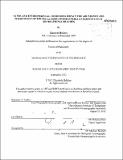| dc.contributor.advisor | Rebecca Gast. | en_US |
| dc.contributor.author | Halliday, Elizabeth (Elizabeth Ann) | en_US |
| dc.contributor.other | Woods Hole Oceanographic Institution. | en_US |
| dc.date.accessioned | 2013-03-01T15:07:09Z | |
| dc.date.available | 2013-03-01T15:07:09Z | |
| dc.date.copyright | 2012 | en_US |
| dc.date.issued | 2012 | en_US |
| dc.identifier.uri | http://hdl.handle.net/1721.1/77457 | |
| dc.description | Thesis (Ph. D.)--Joint Program in Oceanography/Applied Ocean Science and Engineering (Massachusetts Institute of Technology, Dept. of Biology; and the Woods Hole Oceanographic Institution), February 2012. | en_US |
| dc.description | Cataloged from PDF version of thesis. | en_US |
| dc.description | Includes bibliographical references. | en_US |
| dc.description.abstract | The marine fecal indicator Enterococcus is measured at beaches to detect fecal contamination events, and beaches are closed to bathers when Enterococcus is found to exceed the federally mandated limit. This dissertation presents evidence that beach sands are an environmental reservoir of enterococci, tests the relationship between beach sand enterococci and water quality measurements, examines how real-time environmental conditions measured at beaches can be used to better understand and predict water quality violations, and uses molecular methods to provide an alternative characterization of water and sand fecal contamination. Initially, a qPCR method was developed and applied to monitor enterococci DNA in sands. Subsequently this qPCR method was used in tandem with traditional detection of culturable enterococci in sand and water at recreational beaches that have closures every summer. One field season was spent in Maine at beaches in the Wells National Estuarine Research Reserve, where high frequency water and weather measurements are routinely collected in situ. Two field seasons were spent at the beach in Provincetown Harbor, Massachusetts, where a weather station and ADCP were deployed to characterize the environmental conditions associated with observations of elevated enterococci. All studies revealed that environmental variables were related to the distribution of enterococci in sands and water, with water temperature and tides having the strongest relationship to enterococci in water. In dry weather, elevated enterococci in sands were strongly related to the increased moisture content of sands during spring tides. These environmental variables were used in multiple linear regressions to explain a significant amount of the variation observed in environmental enterococci abundance, which notably had no relationship to molecular markers of human fecal pollution. Results suggest that under certain conditions sands can contribute bacteria to the water and that tidal cycles, which are not taken into account in monitoring schemes, can bias routine sampling. | en_US |
| dc.description.statementofresponsibility | by Elizabeth Halliday. | en_US |
| dc.format.extent | 144 p. | en_US |
| dc.language.iso | eng | en_US |
| dc.publisher | Massachusetts Institute of Technology | en_US |
| dc.rights | M.I.T. theses are protected by
copyright. They may be viewed from this source for any purpose, but
reproduction or distribution in any format is prohibited without written
permission. See provided URL for inquiries about permission. | en_US |
| dc.rights.uri | http://dspace.mit.edu/handle/1721.1/7582 | en_US |
| dc.subject | Joint Program in Oceanography/Applied Ocean Science and Engineering. | en_US |
| dc.subject | Biology. | en_US |
| dc.subject | Woods Hole Oceanographic Institution. | en_US |
| dc.subject.lcsh | Pollution Environmental aspects | en_US |
| dc.subject.lcsh | Enterococcus | en_US |
| dc.title | Sands and environmental conditions impact the abundance and persistence of the fecal indicator bacteria Enterococcus at recreational beaches | en_US |
| dc.type | Thesis | en_US |
| dc.description.degree | Ph.D. | en_US |
| dc.contributor.department | Joint Program in Oceanography/Applied Ocean Science and Engineering | en_US |
| dc.contributor.department | Woods Hole Oceanographic Institution | en_US |
| dc.contributor.department | Massachusetts Institute of Technology. Department of Biology | |
| dc.identifier.oclc | 826721613 | en_US |
